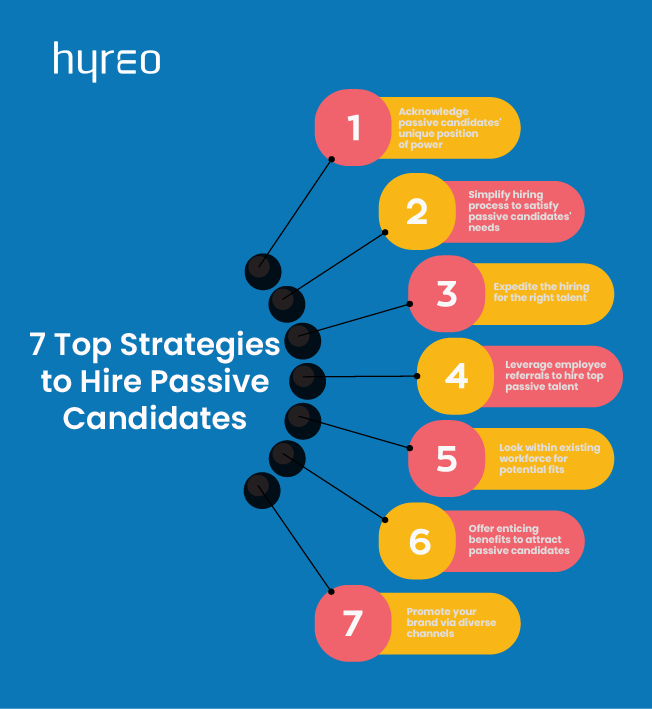Finding the right person to get a job done isn’t like finding a pearl in an oyster or the fountain of youth. All said and done, knowing that the person hired is right for the job is critical to an organization’s success.
Hence, talent acquisition teams constantly seek qualified candidates to meet their business requirements and needs.
However, once the job advertisement is posted online, on social media, job posting sites, and offline, finding the right person for the job begins.
This is when HR managers need to focus on who would be their perfect candidate and how they can sort between them. In most cases, you will come across various candidates. This is when the sorting begins.
Sorting the candidates is necessary as it helps you find the right fit for the right job. However, this applies to active and passive candidates.
While your job advertisement may attract active candidates, looking at the passive ones is also necessary.
This is required in most cases, and if you are relying on only an active job seeker, you are only attracting a talent pool from a limited percentage of active candidates. This is because passive job seekers are not applying for your job advertisements.
According to LinkedIn Hiring Statistics, The global workforce comprises 70% passive and 30% active talent. Recruiters typically use an average of 7.8 different social media handles to source passive candidates. The best candidates are usually off the talent market within ten days.
So how do you define active and passive candidates?
What are Active Candidates?
In simple terms, active job seekers are the ones who are actively looking for jobs. Hence, they are the ones who will be interested in engaging with you. In most cases, active candidates are not employed, but that doesn’t necessarily mean that all active candidates are unemployed.
Various active candidates look for new jobs when their work is outsourced, want to take on new responsibilities or need a change. Hence, they are more actively seeking new roles to offer them monetary and work satisfaction.
What are Passive Candidates?
On the other hand, passive candidates are the ones who are currently employed but are also looking out for new opportunities.
A significant chunk of the workforce falls in this category because many employees seek better career opportunities and work options while actively employed.
Key Differences Between Active and Passive Candidates
When hiring the ideal candidate for your company’s vacant job position, you must understand the differences between active and passive candidates.
Here are seven key differences that would help you differentiate between the two.
| Sr No | Active Candidates | Passive Candidates |
| 1 | Active candidates come to you and apply for the job. They may apply directly on the company’s website or apply through other mediums including job portals as well. | Passive candidates avoid applying for jobs directly and hence you will need to find them. |
| 2 | It does not take a lot to convince them to take up the position in your organization. | You will need to convince them that your organization offers a better opportunity. |
| 3 | Active candidates are applying for several jobs at once and hence the competition can be fierce. | Passive candidates are not applying for jobs but you will still need to grab their attention. |
| 4 | They might not necessarily have the skills you need for your company. | You already know that they have the required skills for the job. |
| 5 | Psychologically, they are more anxious, excited, and eager to find a new offer | Psychologically, they are happy and satisfied and not considering competing offers. |
| 6 | Retaining them might be a hard task especially if a better offer comes along. | It is less likely that they will leave their current position as they are satisfied. |
| 7 | They are very adaptive since they change jobs more than passive candidates | They might not be very adaptive even if your job offer is better. |
7 Key Strategies to Hire Passive Candidates

Regarding talent acquisition, hiring managers must balance active and passive candidates to meet their company requirements. This is important because you need to consider the larger talent pool from which you can choose the perfect candidate for your business.
HR teams and managers must know that the strategies for hiring active and passive candidates would also differ.
When hiring an active job seeker, you first spread the message, receive job applications, and then find the right match as per your needs.
On the contrary, with passive candidate hiring, you must first define your needs and then find the matches.
Hiring active candidates would often be enough for your organization’s needs.
However, if you plan to sort through a bunch of suitable passive job seekers, you must have the right talent acquisition strategy to grab their attention.
Here are 7 key strategies to hire passive candidates.
#1 Understand that They Have the Leverage
Even before you get started with the recruitment process for passive candidates, you need to have a clear understanding that they have leverage in the hiring process.
Since you are going to them, they can decline your offer outright. Also, they can negotiate for what they want from the role you offer.
This understanding would make it easier for you to manage the entire recruiting process easily and conveniently.
#2 Streamline the Recruiting Process
While active candidates can undergo many interview rounds, things are different with passive candidates.
They already have a job and would like to go through fewer rounds of interviews, test assignments, and complicated and annoying application processes.
#3 Improve the Hiring Speed
Knowing the ideal candidate is the key to speeding up the hiring process.
Hence, it would be best not to waste time once you have locked down on the candidate that meets all your company’s needs and requirements.
If you take too long to decide, you might lose out on the candidate, which can even send a negative message about your company’s work culture and poor recruitment strategy.
#4 Ask for Referrals
Referrals can work wonders when you are seeking a passive job seeker. You can spread the word within your organization and let current employees recommend colleagues.
Referrals offer bi-fold benefits. Firstly, your employee would know precisely what the company is looking for and the company culture. Hence, he or she will tell someone who is the right fit for the job.
Secondly, if the company hires the referred person, it powerfully conveys that it values employees’ opinions.
You can speed up the hiring process with the right employee referral programs.
#5 Look Within the Organization
A passive candidate doesn’t necessarily mean someone with a job with another company. You can look within your company and find someone who may not be looking for a new job or position but has the right skills for the vacant post.
Although the candidate may not apply for the job, you can still approach the employee and ask if they are interested in growth opportunities.
Even if they aren’t interested, you can always thank them for their time and ask them to spread the word.
#6 Better Incentives
Passive candidates would require much more than convincing to join your organization.
Hence, you need to provide them with better incentives and bonuses.
Review what you offer them even before you approach them to ensure you don’t waste their time.
You can also provide them with flexible schedules, work time, and remote work opportunities that would help them save commute time.
#7 Promote Your Brand
It is essential to know that passive candidates are happy with their current job.
Hence, it would take more than just monetary benefits.
In some instances, you can leverage brand value to attract them through blogs, social media posts, and other online and offline methods.
Many high-quality candidates today would want to work in some of the top organizations, and therefore you can use the spotlight on the brand to attract various passive candidates.
Conclusion
Recruiting both active and passive candidates can be challenging.
However, when you have the right strategies to attract them, you can get things done right.
While you can always find an ideal candidate through a regular interview process you can always opt for passive candidates that would bring more to the table.
However, you need to streamline the hiring process and also be quick enough to grab them before rival companies take them or if they lose interest in your organization.
Recommended Reads: A guide to assessing Candidate Resumes Steps to build a Diverse & Multilingual team Top job boards to source amazing talent
FAQs on Active and Passive Candidates
Why are passive candidates more critical than active candidates?
Passive candidates statistically are more qualified for the said job position. Also, they are not seeking jobs to improve their skill set. They already have the required competencies, and therefore they need less training.
What tools are best to attract a passive job seeker?
You can use all kinds of outbound candidate sourcing techniques to attract a passive job seeker like employee referrals, social media, online job postings, online and offline networking events, technology communities, and other methods.
Why should you streamline your recruitment process?
A quicker recruitment process would ensure that the hiring process is done quickly. Also, it sends a message that you have clarity on what you are looking for in your organization’s needs. It also enhances candidate experience and improves overall brand value in the market.
Are all passive candidates happy with their current jobs?
Probably not. However, they are not actively looking for jobs or applying for new positions or roles.
Are active candidates less valuable than passive candidates?
Not really.
You can find a perfect candidate for your organization as an active candidate.
However, it is debated that they would jump ship if someone threw a better offer.
Also, they are looking for jobs to improve their skills and will need more training. On the other hand, they can become loyal and trustworthy employees for the opportunity you provided.




